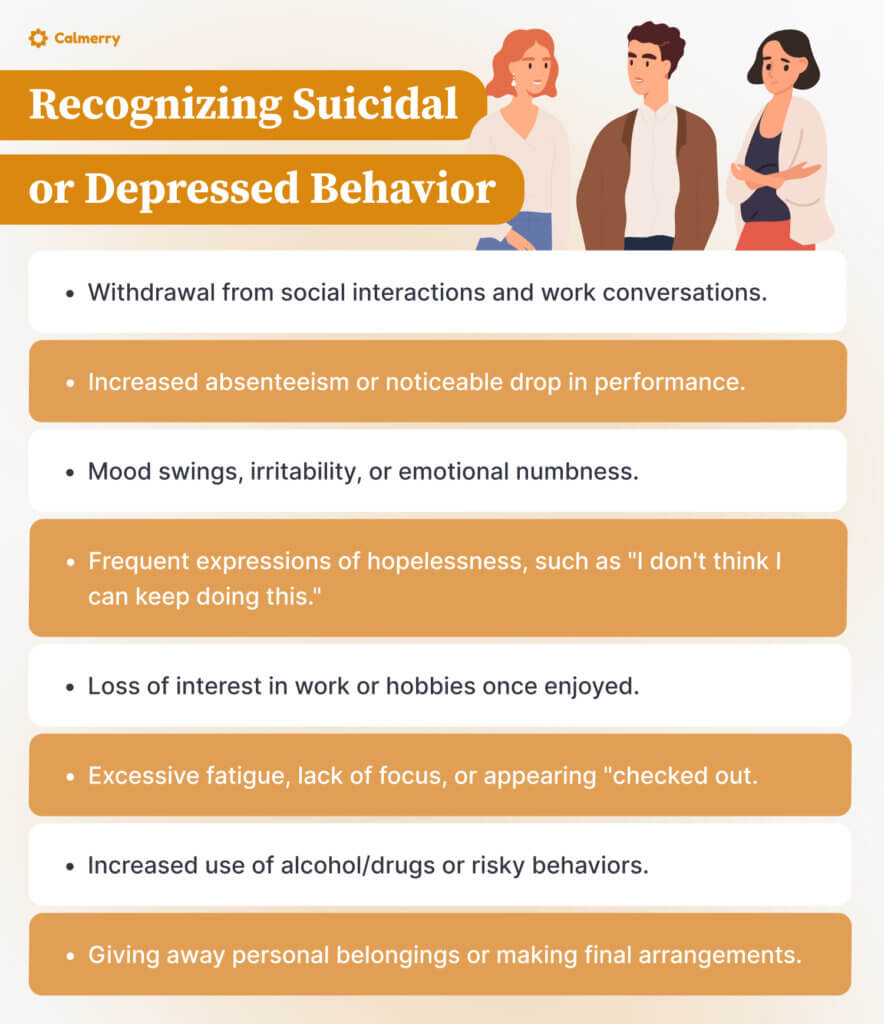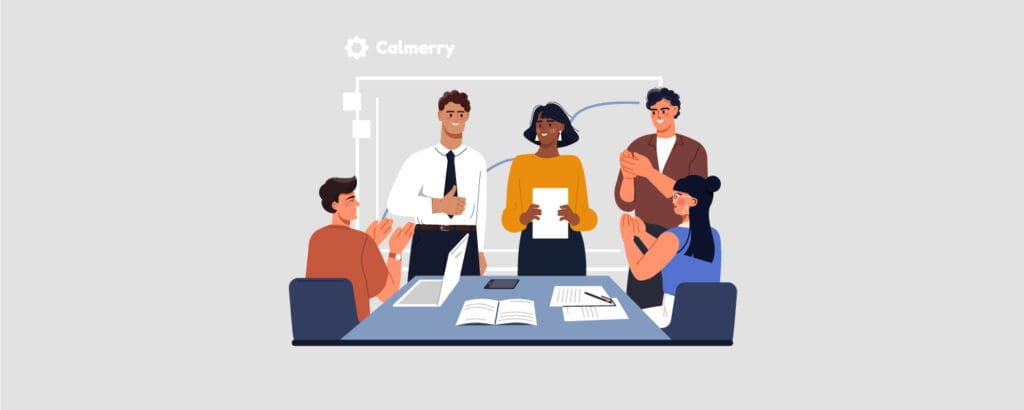How HR Can Foster Mental Health & Suicide Prevention in the Workplace

In this article
Mental health plays a crucial role in workplace well-being. Employees who feel psychologically safe and supported are more engaged, productive, and less likely to experience burnout. Organizations that prioritize mental health create inclusive, thriving work environments where employees can perform at their best.
Conversations about mental health don’t just help one individual—they create ripples that foster a culture of openness and healing. This guide provides HR professionals and business managers with actionable steps to build a mental health-friendly workplace, recognize signs of distress, and respond effectively to crises.
“When you start talking about mental health, you unlock somebody else’s prison.” Gretchen Schoser, Award-Winning Podcast Co-Host | Mental Health Advocate
Creating a Supportive Mental Health Culture
A workplace culture that prioritizes mental health ensures employees feel safe discussing their challenges without fear of stigma or job security risks. This begins at the leadership level and requires continuous reinforcement across the organization. Creating a culture of mental health support goes beyond offering resources—it requires embedding psychological safety into everyday workplace interactions. Employees should feel confident that their mental well-being is valued as much as their performance, and that seeking support won’t jeopardize their career growth.
Steps to implement:
- Encourage leadership to model open conversations about mental health.
- Train managers to check in with employees beyond work performance, ensuring they feel valued as individuals.
- Normalize mental health days and stress breaks by incorporating them into HR policies.
- Provide an anonymous employee feedback system for reporting mental health concerns.
- Recognize and celebrate World Mental Health Day and other awareness events.
Example:
A monthly team meeting could include a five-minute mental health check-in where employees share self-care tips or wellness practices.
Suicide Prevention in the Workplace
Suicide prevention begins with awareness and providing employees with the resources they need. A proactive approach ensures that everyone knows where to seek help before a crisis occurs. Employers should also foster a non-judgmental environment where struggling employees feel safe enough to reach out without fear of repercussions.
Key actions:
- Display crisis hotline numbers (e.g., 988) in break rooms, HR emails, and company websites to ensure accessibility for employees who need immediate support.
- Provide Mental Health First Aid Training for managers and employees so they feel equipped to recognize and address distress signals, fostering early intervention before issues escalate.
- Develop a crisis response plan outlining specific steps to take if an employee expresses suicidal thoughts, ensuring a structured, compassionate response rather than uncertainty or avoidance.
- Partner with mental health professionals to offer periodic workplace training on managing stress, resilience, and self-care, reinforcing the message that mental wellness is an ongoing priority.
Example:
A company could invite a mental health expert for quarterly workshops on handling workplace stress and mental well-being.
Recognizing Suicidal or Depressed Behavior
Employees struggling with their mental health often show subtle warning signs before reaching a crisis point. Being aware of these signs allows HR professionals and managers to intervene early and offer support. Recognizing the signs is the first step in preventing a crisis; proactive support can change the trajectory of someone’s mental health journey.
One crucial point often overlooked is that extroverts can be struggling just as much as introverts—sometimes even more so. Extraverts may mask their struggles behind humor, energy, or social interactions, making their pain harder to detect. If a typically outgoing employee suddenly withdraws or begins exhibiting uncharacteristic behavior, it’s essential to check in.

Example:
If a normally engaged employee suddenly becomes withdrawn and disengaged, managers should check in with them privately to offer support.
Providing Inclusive Mental Health Support
Different communities have unique mental health needs, and companies should ensure that resources reflect those diverse experiences. “If they don’t feel safe in the workplace, when they walk out the doors, they’re still not going to feel safe.” Inclusivity is a key component of mental health support—it’s about creating environments where every employee feels seen and understood.
“If they don’t feel safe in the workplace, when they walk out the doors, they’re still not going to feel safe.” Gretchen Schoser, Award-Winning Podcast Co-Host | Mental Health Advocate
Ways to create inclusive mental health support:
- Offer therapy and resources tailored to diverse communities (LGBTQ+, BIPOC, neurodivergent individuals, etc.). Employees should have access to mental health professionals who understand their cultural and identity-based experiences.
- Provide multilingual mental health materials and crisis hotlines. Language barriers should never prevent an employee from seeking help.
- Recognize and respect different coping mechanisms and cultural attitudes toward mental health. Different backgrounds influence how individuals process stress and trauma—offering flexibility in mental health programs ensures effectiveness.
- Celebrate mental health awareness throughout the year—not just during designated months. Incorporating year-round initiatives fosters a truly inclusive culture rather than a one-off event.
- Encourage peer groups focused on wellness and inclusion. Creating internal support networks allows employees to feel understood by their peers.
Example:
A company might offer mental health resources specifically for employees who identify as LGBTQ+ or provide culturally competent counseling options.
What to Do If a Workplace Suicide Occurs
We hope that no one reading this will ever experience the loss of a coworker to suicide, but if such a tragedy occurs, handling it with sensitivity, transparency, and immediate support is crucial. The way an organization responds can have a lasting impact on employee morale and mental well-being.
Steps to take:
- Communicate with sensitivity and transparency. Avoid vague, corporate-sounding emails; instead, acknowledge the loss while respecting privacy.
- Provide grief support resources such as counseling services, employee support groups, and referrals to mental health professionals.
- Offer an open space for employees to process their emotions, such as a remembrance initiative or private group sessions.
- Follow up over time. The impact of a workplace loss does not fade in a week—continue to check in with affected employees.
- Ensure leadership expresses compassion through personal messages, not just formal HR statements.
The absence of proper communication after a workplace suicide can lead to confusion, guilt, and increased stress among employees. If the event is ignored or downplayed, employees may feel unsupported in their grief, which can impact their overall well-being and productivity. Providing a safe space to talk, offering long-term grief support, and maintaining open conversations about loss can help employees heal while ensuring they know they’re not alone.
Example:
A company could arrange a moment of silence or a donation in the person’s honor rather than simply moving forward with business as usual.
💡 Key Takeaways:
Creating a mental health-friendly workplace is not just an HR initiative—it’s a cultural shift. A simple, compassionate conversation and a proactive mental health approach can save lives and foster a workplace culture of safety and inclusion.
At Calmerry, we help businesses build that culture by providing accessible mental health support for employees. From on-demand therapy sessions with licensed professionals to tailored coaching programs that address workplace stress and resilience, our platform is designed to meet the unique needs of your team. Whether you’re looking to offer structured mental health benefits or equip managers with tools to support their employees, Calmerry makes it easy to integrate well-being into your workplace.



